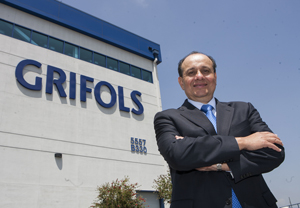When the 710 freeway dumps you at the foot of Grifols Biologicals Inc.’s campus in East Los Angeles, about all you can see is a large cornflower blue and white warehouse. But that sleek building obscures a massive complex with 160,000 square feet of new buildings, with more under construction.
Grifols, the L.A.-based manufacturing arm of its Spanish biotech parent, is growing. The local operation, which converts blood proteins into therapeutic medicine, has invested $160 million over the last five years to increase its production capacity. With that growth has come an addition of more than 250 biomanufacturing jobs, and the company stands to add about 125 in the next couple of years.
But filling those positions with qualified candidates may get harder and harder. The number of qualified graduates coming out of the local community colleges and technical schools feeding the area’s bioscience firms are barely keeping pace with demand, a great concern at a time when the sector is starting to boom.
A survey by the Southern California Biomedical Council, or SoCalBio, found that local bioscience companies will need to hire at least 400 workers in the next two years, far more than the roughly 150 coming out of local technical training centers each year.
While that gap might not be massive, it does not take into account the prospect of hundreds more workers that will be needed as companies like Santa Monica’s Kite Pharma Inc. ratchet up production.
Further complicating matters, more than half of the workers now being trained are coming from a relatively new program at Los Angeles Valley College funded by a Labor Department grant that expires next year.
Though the wages for these jobs are not high – the best paying start at around $16.50 an hour – the stakes are. In addition to being qualified to work in the labs, employees are required to treat day-to-day notes at Food and Drug Administration-approved labs as legal documentation.
Grifols and other local bioscience firms have tried to shore up the talent pool by forging tight relationships with area technical training centers. The firms offer students tours of their operations, guest lectures, donations and a clear idea of how to do the jobs for which they’re hiring. For example, the director of a new biomanufacturing program being developed at Citrus College actually shadowed workers at Grifols and other firms.
Willie Zuniga, president of Grifols, said the training provided by these programs speeds the integration process once people are on the job.
“You’re not having to teach them the metric system from scratch,” he said. “These individuals pick it up quicker, are better prepared … more aware of what they’re getting into.” Consequently, the candidates with training are more likely to stick around once on the job.
Without a trained workforce, the same might not be said for the companies seeking to hire.
“You have to grow the talent locally, otherwise companies are going to relocate manufacturing somewhere else in order to accomplish what they want,” said Ahmed Enany, president of SoCalBio.
Enany helped secure the initial federal grant that funded the Valley College program and now wants to see the program spun off as an independent nonprofit funded by local workforce investment boards, foundations and companies.
For his part, Lennie Ciufo, founding director of Valley College’s job training program, said he would preserve his program if an independent training center were established.
“It doesn’t mean that we couldn’t still maintain it at our college and expand at other sites or one general site,” he said “It’s a matter of expanding … our college alone will not be able to meet the capacity of the region.”
Back to school
Zuniga, who worked his way up from an entry level position at Alpha Therapeutic Corp., which was later acquired by Grifols, thinks there’s a large enough pool of candidates for now, but he would like to see more training programs.
But setting them up is expensive. Ciufo noted that about one-tenth of the $1.8 million Labor Department grant the school received, paid out over four years, went to equipping its lab. That program, now in its third year, has ramped up to producing about 80 graduates each year, but will run out of money in the next year.
“We’re trying to find other funding through different sources,” Ciufo said. “We’re not going to let it go.”
Other companies forging partnerships with area community colleges include Gilead Sciences Inc. in San Dimas, Baxter BioScience in Glendale and ProLacta in the City of Industry.
Kite, which has ballooned to more than 80 employees from just 20 last spring, is in the process of building out its clinical supply manufacturing plant in a portion of an 18,000-square-foot building in Santa Monica formerly occupied by Agensys Inc.
Kite, which hasn’t started production yet, has been mostly staffing up with higher-level employees. But Prentice Curry, its vice president of quality and operations, said the day will come when it will need qualified low-level employees – and lots of them.
The company is finalizing designs for its El Segundo commercial manufacturing facility, with a 60,000-square-foot capacity. It doesn’t have firm numbers for how many manufacturing workers it’ll need when it hopes to go on line in 2017.
“It’s certainly likely in the hundreds,” said Curry.

